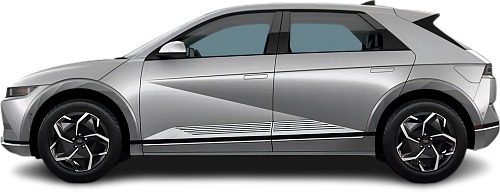Global EV Comparison: Hyundai Ioniq 5 Standard Range AWD vs BMW i4 M50
Struggling to Decide? Let AI Help!
Your AI Summary Is Ready!
General Info
Since both vehicles have been discontinued, they are now only available on the used car market. You can get the Hyundai Ioniq 5 Standard Range AWD (2021-2022) for as low as €33900, while the BMW i4 M50 (2021-2024) begins at €47700.
The Hyundai Ioniq 5 Standard Range AWD (2021-2022) is a SUV, whereas the BMW i4 M50 (2021-2024) is a Liftback.
| Property | Hyundai Ioniq 5 Standard Range AWD | BMW i4 M50 |
|---|---|---|
| Years of Production | 2021-2022 | 2021-2024 |
| Current Status | Discontinued | Discontinued |
| Country of Manufacture | Indonesia, Singapore, South Korea | Germany |
| Body Style | SUV | Liftback |
| Market Availability | EU | EU, USA |
| Price Europe (Used) | €33900 | €47700 |
| GCC Score | 6.4 | 6.5 |
Range and Efficiency
While the BMW i4 M50 (2021-2024) offers a longer real-world range and a bigger battery, it is less energy-efficient than the Hyundai Ioniq 5 Standard Range AWD (2021-2022).
| Property | Hyundai Ioniq 5 Standard Range AWD | BMW i4 M50 |
|---|---|---|
| Range (EPA) | - Range (EPA) | 435 km |
| Range (WLTP) | 362 km | 519 km |
| Range (GCC) | 308 km | 409 km |
| Battery Capacity (Nominal) | 58 kWh | 83.9 kWh |
| Battery Capacity (Usable) | 54 kWh | 80.7 kWh |
| Efficiency per 100 km | 17.5 kWh/100 km | 19.7 kWh/100 km |
| Efficiency per kWh | 5.7 km/kWh | 5.07 km/kWh |
| Range and Efficiency Score | 5.9 | 6.5 |
Charging
The Hyundai Ioniq 5 Standard Range AWD (2021-2022) features an advanced 800-volt architecture, whereas the BMW i4 M50 (2021-2024) relies on a standard 400-volt system.
The BMW i4 M50 (2021-2024) offers faster charging speeds at DC stations, reaching up to 207 kW, while the Hyundai Ioniq 5 Standard Range AWD (2021-2022) maxes out at 175 kW.
Both vehicles are equipped with the same on-board charger, supporting a maximum AC charging power of 11 kW.
| Property | Hyundai Ioniq 5 Standard Range AWD | BMW i4 M50 |
|---|---|---|
| Max Charging Power (AC) | 11 kW | 11 kW |
| Max Charging Power (DC) | 175 kW | 207 kW |
| Architecture | 800 V | 400 V |
| Charge Port | CCS Type 2 | CCS Type 2 |
| Charging Score | 6.9 | 6.9 |
Performance
Both vehicles are all-wheel drive.
The BMW i4 M50 (2021-2024) boasts greater motor power and accelerates faster from 0 to 100 km/h.
| Property | Hyundai Ioniq 5 Standard Range AWD | BMW i4 M50 |
|---|---|---|
| Drive Type | AWD | AWD |
| Motor Type | PMSM (front), PMSM (rear) | PMSM (front), PMSM (rear) |
| Motor Power (kW) | 173 kW | 400 kW |
| Motor Power (hp) | 232 hp | 536 hp |
| Motor Torque | 605 Nm | 795 Nm |
| 0-100 km/h | 6.1 s | 3.9 s |
| Top Speed | 185 km/h | 225 km/h |
| Performance Score | 4.8 | 6.7 |
Dimensions
The Hyundai Ioniq 5 Standard Range AWD (2021-2022) is wider and taller, but the BMW i4 M50 (2021-2024) is longer.
The Hyundai Ioniq 5 Standard Range AWD (2021-2022) boasts a more extended wheelbase.
| Property | Hyundai Ioniq 5 Standard Range AWD | BMW i4 M50 |
|---|---|---|
| Length | 4635 mm | 4783 mm |
| Width (with Mirrors) | 2152 mm | 2073 mm |
| Width (w/o Mirrors) | 1890 mm | 1852 mm |
| Height | 1605 mm | 1448 mm |
| Wheelbase | 3000 mm | 2856 mm |
Cargo and Towing
The Hyundai Ioniq 5 Standard Range AWD (2021-2022) provides more cargo capacity, featuring both a larger trunk and more space with the rear seats folded.
A frunk (front trunk) is available in the Hyundai Ioniq 5 Standard Range AWD (2021-2022), but the BMW i4 M50 (2021-2024) doesn’t have one.
The BMW i4 M50 (2021-2024) has a towing capacity of up to 1600 kg, whereas the Hyundai Ioniq 5 Standard Range AWD (2021-2022) is not officially rated for towing in the EU.
| Property | Hyundai Ioniq 5 Standard Range AWD | BMW i4 M50 |
|---|---|---|
| Number of Seats | 5 | 5 |
| Curb Weight | 2015 kg | 2290 kg |
| Cargo Volume (Trunk) | 531 l | 470 l |
| Cargo Volume (Max) | 1591 l | 1290 l |
| Cargo Volume (Frunk) | 24 l | - Cargo Volume (Frunk) |
| Towing Capacity | - Towing Capacity | 1600 kg |
| Cargo and Towing Score | 6.6 | 5 |




